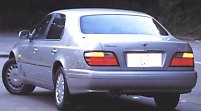 Korean
enterprise chairmen have two cars to choose from - Hyundai Equus or
Ssangyong
Chairman (previously badged as Daewoo when Ssangyong was owned by
Daewoo).
While the former is an American style long-and-bulky limousine, the
latter
sounds and drives like a European luxurious sedan. In fact, Ssangyong
Chairman
was developed by Ssangyong with the help from Mercedes based on the
previous
generation S-class (yes, that big monster). As Ssangyong bankrupted in
1998, Daewoo took over the SUV maker accompany with the Chairman, which
fits well into its range to be the range topper. Korean
enterprise chairmen have two cars to choose from - Hyundai Equus or
Ssangyong
Chairman (previously badged as Daewoo when Ssangyong was owned by
Daewoo).
While the former is an American style long-and-bulky limousine, the
latter
sounds and drives like a European luxurious sedan. In fact, Ssangyong
Chairman
was developed by Ssangyong with the help from Mercedes based on the
previous
generation S-class (yes, that big monster). As Ssangyong bankrupted in
1998, Daewoo took over the SUV maker accompany with the Chairman, which
fits well into its range to be the range topper.
You know, Mercedes used to supply engines to Ssangyong’s off-roaders. The Chairman lifted the technical cooperation to new height. Since 1993, Mercedes has been the major technical consultant to Ssangyong. It sent 39 engineers to Korea for development of the car and trained the Korean engineers. The styling was penned by the same designer of SLK and new S-class. The rear-drive, 5-meter long floorpan is derived from the old S-class W140, with similar multi-link rear suspension but MacPherson strut up front. 2900 mm wheelbase is halfway between the E-class and W140, thus provide abundance of cabin room. If not enough, a long wheelbase version can be chosen to extend that to over 3 meters. Talking about the cabin, it is really very well finished. The design follows the tradition of Mercedes to be neat, no-nonsense and rock solid. You can’t see the gimmicks in new S-class or C-class, but many people, especially Korean, actually prefer tradition. Of course, for a car costing just a third of a S-class, you can’t compare them directly. The plastic quality isn’t up to world standard. The Bif-style Korean wood decoration might not be everybody’s taste. Big leather seats, on the other hand, looks as good as sit. This is a Chairman’s car, so the rear seat received more attention to details. Open the doors, the seat will slide back a few inches to aid access. Close the doors, the seat will move back to its memorized position. Another boss-pleasing feature is: the boss can control the position of front seats via a control panel in the rear arm rest to make more rear leg room whenever necessary, by the way, to punish the driver if he doesn’t show the respect to the chairman expected. On the other hand, the secretary in the front passenger seat can check the electronic diary in the LCD touch screen locating in center console. The screen also provides touch phone for making appointment for the boss. On the road, the short wheelbase version handles quite nimble considering its length, partly thanks to the relatively lightweight of 1635 kg, partly thanks to the suspension tuning which is a good compromise between ride softness and body control. Compare with Mercedes, it is still bias towards soft - what else can you expect for an Asian boss car ? However, it is not soft to the extent of Hyundai Equus and even the smaller XG, thus provide more driver appeal. The Chairman is a bit short of power, because the only choice for engine is the old Mercedes 3.2-litre straight six. The 24-valve, 220 horsepower unit was discarded by the 3-pointed star a few years ago. It is smooth but less quiet than the new V6 at high rev. Nevertheless, sound insulation of the cabin is very impressive. Engine noise, wind noise and tyre roar are also insulated to very low level. Moreover, Mercedes generously offers its world-beating 5-speed automatic whose shift is so seamless that the boss can concentrate on reading newspaper without disturb. Overall speaking,
the Chairman
is very mature and well finished. It still lacks the ultimate
refinement
of German prestige and Lexus (well, M-B just transfer the second-hand
technology
to the Korean). As a boss car, it is definitely better than Hyundai
Equus.
However, the most convincing strength reflects in the price tag - for
the
money of a 3-series, you can enjoy a Korean S-class. What do you think
? |
| The above report was last updated on 9 July 2000. All Rights Reserved. |